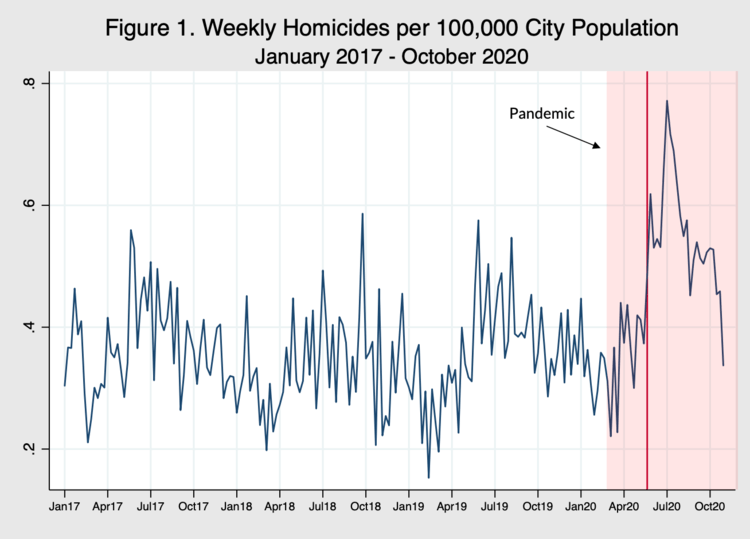
Libertarians: Did Semi-Decriminalizing Drugs In 2020 Reduce Murders Like You Theorized?
By Steve Sailer
01/10/2021
Libertarians often blame America’s high murder rate on drug laws. In 2020, though, drug laws were either repealed or not enforced much due to covid, BLM, defund the police, etc.
So, what happened?
Murders went up 37.9% over 2019 in urban American.
Criminologist Richard Rosenfeld’s report for the National Commission on Covid-19 and Criminal Justice — Pandemic, Social Unrest, and Crime in U.S. Cities — has a useful graph showing the decline in drug arrests. He’s using a smaller sample of cities than I have for my comparison of homicide totals in 2020 to 2019, but he has weekly data for a variety of crimes.
Drug offenses include arrests for the manufacture, sale, or possession of illicit drugs. The weekly drug offense rate exhibited a downward cyclical trend until the structural break in March of 2020, when the rate fell sharply and then fluctuated during the next several months. Overall, the drug offense rate between March and October 2020 decreased by 32.4% over the same period in 2019, dropping to a level far lower than at any time during the previous three and-a-half years.

The red line represents a “structural break” in March (i.e., social distancing, cops reluctant to get in perps’ faces for fear of infection, etc.).
In contrast:
Figure 1 displays the average weekly homicide rate in the 21 cities for which homicide data were available (see Appendix). There appears to be a rough cyclical pattern in the homicide rate over time. The model estimated a structural break at the end of May 2020, after which the homicide rate increased sharply through July. It then dropped through the end of October, though not to the level during the same period the year before. The average city homicide rate during the pandemic (March to October of 2020) increased by 32% over the same period the year before (see Figure 2).3 The homicide rate between June and August of 2020 (labeled “Summer” in Figure 2) was 41.9% higher than during the same months in 2019, and it was 34.2% higher in September and October (labeled “Fall”). There were 610 more homicides in the 21 cities in the summer and fall of 2020 than during the same period in 2019. Year-to-date (January to October), the homicide rate was 29% higher in 2020 than in 2019.

The red line represents a different structural break, this one in the last week in May: i.e., the George Floyd memorial summer of pillage and mayhem.
One question is how much of murder in 2020 is driven by the kind of business logic that Michael Corleone would recognize and how much is driven by stupid interpersonal beefs that Sonny Corleone would recognize? Jill Leovy, the L.A. Times’ murder reporter, emphasized the latter. Watching The Wire tends to give white people an inflated impression of how much black-on-black murder is driven by drug business rationality, when much is just idiots killing each other in lame squabbles.
But I don’t really know how to measure that.
